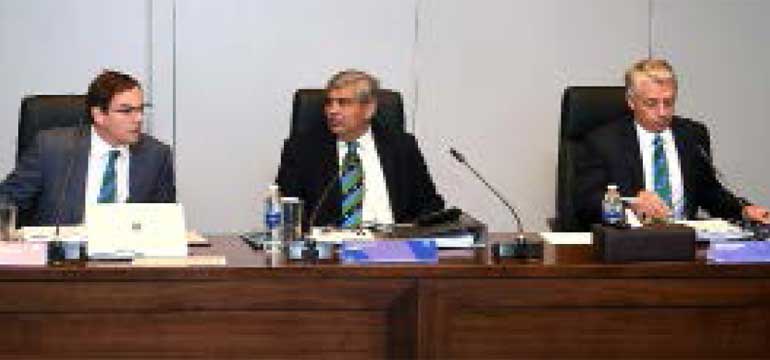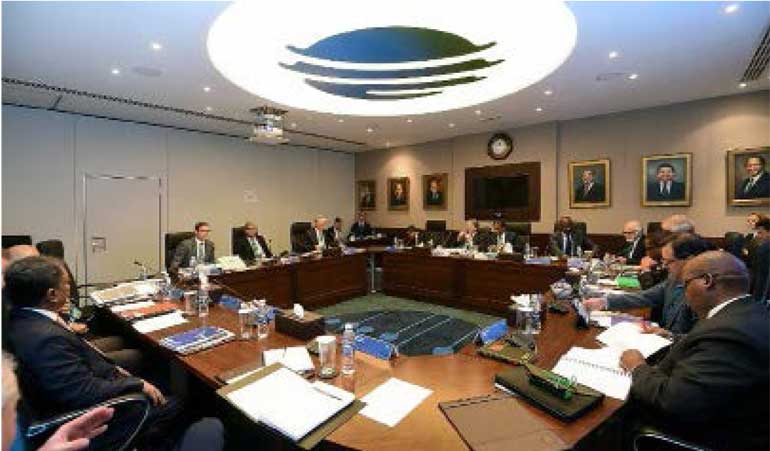Tuesday Jan 14, 2025
Tuesday Jan 14, 2025
Monday, 6 February 2017 01:07 - - {{hitsCtrl.values.hits}}
ESPNCricinfo: The ICC has, in principle, passed a new constitution that undoes much of the imbalance in power and finances the Big Three had attempted to create in 2014. But in practice it may require more negotiations, particularly on a new revenue-distribution model, before it becomes the new reality. A final decision on that will be taken at the ICC Board’s next round of meetings in April.

10 of the 13 ICC Board members present on Saturday (the three Associates representatives’ do not have voting rights) voted in favour of the new draft constitution, which puts forward a new governance and financial model. The BCCI, which stands to lose the most in projected ICC revenues under this model in the post-Big Three world, objected, and made its reservations public through a release. ESPNcricinfo understands Sri Lanka Cricket (SLC) also voted against the new model while Zimbabwe Cricket (ZC) chose to abstain from voting.
The new constitution and governance structure, including a new revenue distribution model, was prepared by a five-man working group led by ICC chairman Shashank Manohar. The group, which started work last February, had consulted the Full Members as well as the Associations before drafting the new model.
The new financial model, the details of which remain a closely guarded secret, was always expected to be a sticking point in today’s meeting - given the lack of time the BCCI representative Vikram Lamaye had to prepare for the meeting (he was handed the BCCI role by the Supreme Court of India only on January 30), even more so. Various estimates have placed the BCCI’s projected cut in ICC earnings anywhere between $ 150 million and nearly $ 300 million for the 2015-2023 ICC rights cycle. The ICC said the basis for the new financial model was developed based on certain “guiding principles” that included “equity, good conscience, common sense and simplicity” among others.

However the BCCI, represented by Limaye, voted against the proposed new constitution and revenue model. Explaining the reason for its stance, the BCCI said the Court’s newly appointed Committee of Administrators, of which Limaye is part, had insufficient time “to take an informed view on the said proposal”.
The BCCI specifically questioned the science behind the projected figures arrived at by Manohar’s working group. Ironically this was a concern for many members opposed to the original Big Three revenue distribution model. “At the ICC Board meeting today in Dubai, there was an agenda item for discussion on a proposed new financial model and governance structure of the ICC,” the BCCI said in a media release. “The BCCI representative, Vikram Limaye expressed his concern over both the documents especially in light of the insufficient time available to the Supreme Court-appointed Committee of Administrators to take an informed view on the said proposal, and also there being no scientific basis behind the percentage distribution allocation that was being proposed other than “good faith and equity”.
Despite this difference of opinion, the atmosphere inside the meeting was said to be free of the kind of tensions and obstructionism that marked the Big Three meetings in 2014. The BCCI wanted to defer a vote but Shashank Manohar, the ICC chairman and a driving force behind these proposals, was eager to push through, in principle at least, a draft of a constitution, with the proviso that key details of it would be up for debate and discussion.
Manohar stressed that the “principle of change” was no longer up for debate. “Today was an important step forward for the future of the ICC and cricket around the world,” he said. “The proposals from the working group to reverse the resolutions of 2014 and deliver a revised constitution and financial model were accepted by the ICC Board and now we will work collectively to refine the detail for final sign off in April. This also allows the new BCCI leadership appropriate time to appraise the detail and contribute.
“I want the ICC to be reasonable and fair in our approach to all 105 Members and the revised constitution and financial model does that. There are still details to work through and concerns to be addressed, but the principle of change is agreed and not for debate.”
It is thought that the broad contours of the new constitution will remain as passed today. The financial model will, of course, be the subject of negotiation not just for the BCCI but for other Full Members as well.
If the new model is accepted, it will bring in significant changes to the way cricket is run. International cricket structures, as ESPNcricinfo reported on Friday, are on the verge of being altered radically. The push toward providing more context to bilateral cricket and using them as a means towards qualification for global competitions was the basis of the new structures discussed and approved by the ICC’s Chief Executives Committee (CEC) this week.
On Saturday, the ICC confirmed that the “preferred model” that gained consensus among all the members included: a nine-team Test league to be played over a two-year period, a 13-team ODI league played over a three-year period leading into qualification for the 2023 World Cup, and a regional qualification process for the World T20.
The ICC said a final plan would be drawn up at a scheduling summit in March. “This framework will now be used to build a more detailed model that incorporates scheduling and accommodates existing agreements to present to the ICC Board for full consideration in April,” the ICC said.
There are also likelier to be fewer ICC committees in the new constitution. And, unlike the Big-Three model that concentrated power in the hands of a few members, the new structure envisages power to be distributed to member boards in a more equal manner. All members who sit on the Board will carry equal voting rights under the new model, which has also prescribed the appointment of an independent female director on the ICC Board.